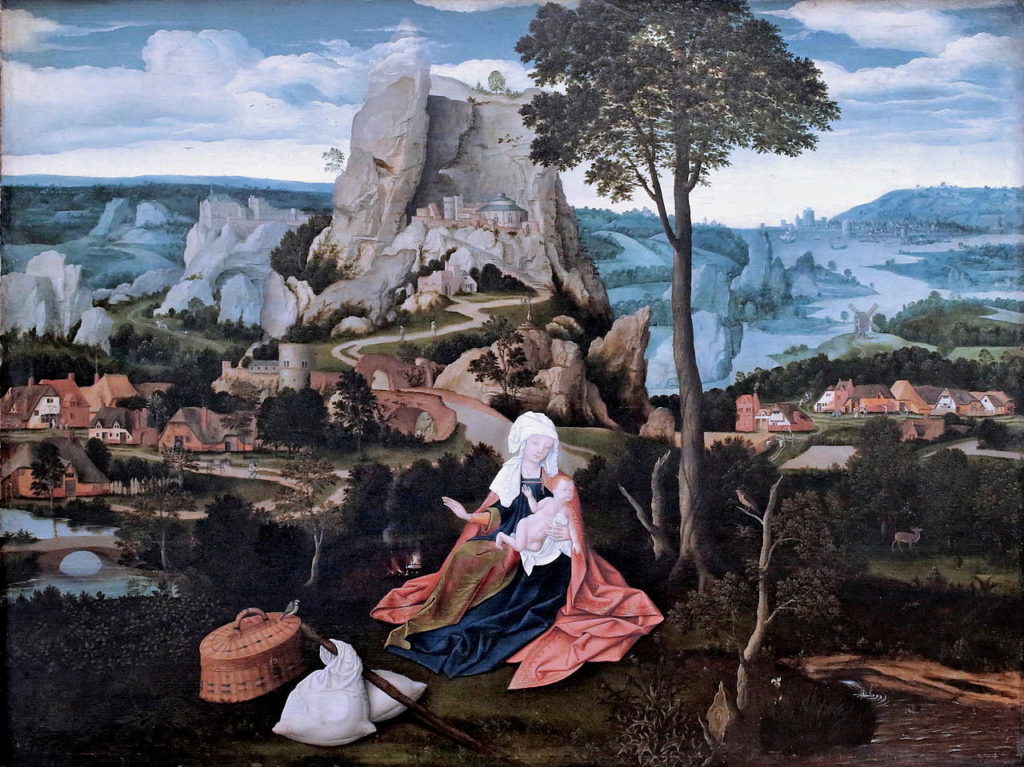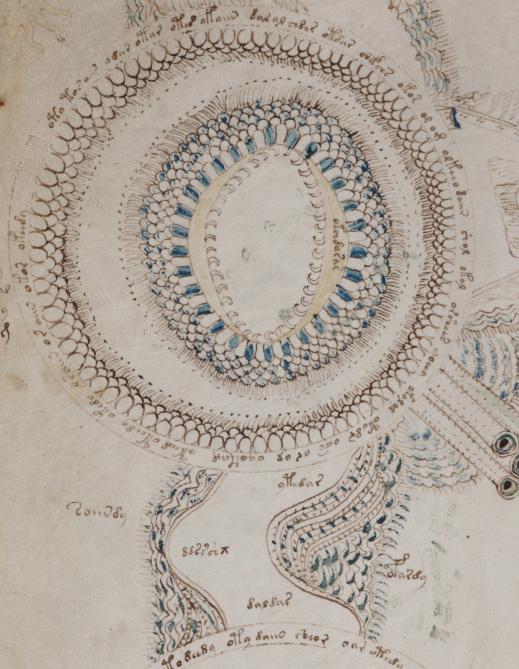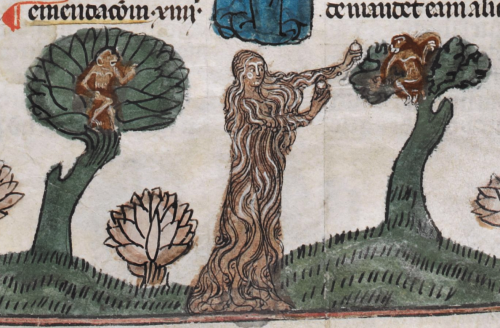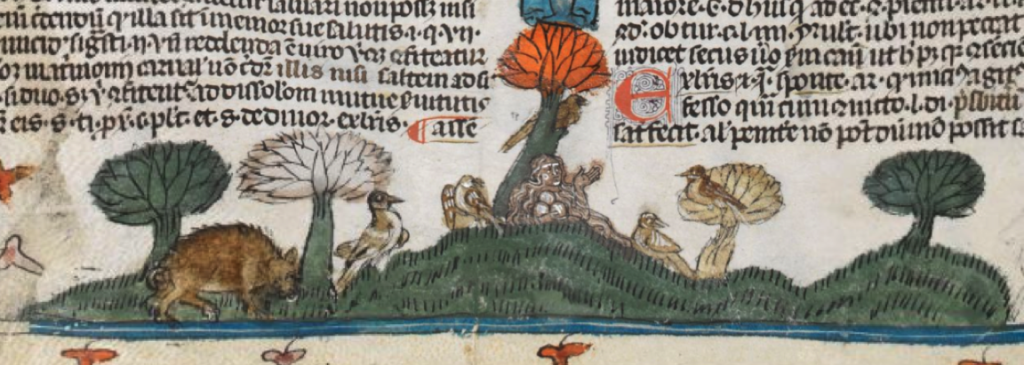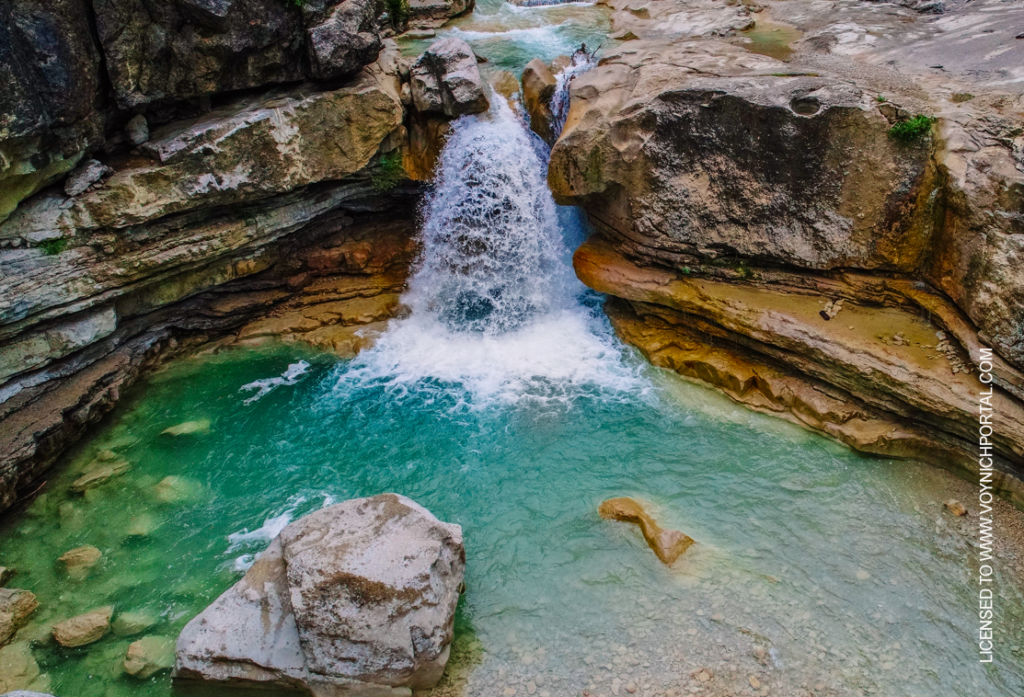12 August 2019
This is yet another idea I had for the VMS “map”. It may not be the best one, I’m still partial to a couple I’ve posted before, but Christian themes are getting attention at the moment, so I decided to add it because it is based on a different interpretation for the flame-like shapes inside the VMS mountain.
Most of the time I think of the wavy lines inside the VMS “crater” as flames or water but it has also occurred to me that they might be teeth or celestial waves. For example, in this nativity scene, rather than a halo, there are wavy rays in a rough mandorla shape emanating from the Christ child:
If the wavy lines in the shape that looks like a mountain on the VMS “map” are celestial rays, rather than fire or water, then there’s another location that might fit the “map”…
So let’s assume for the duration of this blog that the toothlike curves indicate some special status.
The lines in the VMS crater don’t aim outward, they aim toward the center, so perhaps the mountain itself is a sacred place (or a hollow within it). In this nativity relief carving, the archway rays point inward, so the direction of the rays is context dependent.
Many mountains were considered sacred in Pagan times and the transition from Paganism to Christianity occurred gradually, so there are Christian shrines built into hillsides, and numerous nativity scenes drawn within the framework of a mountain:
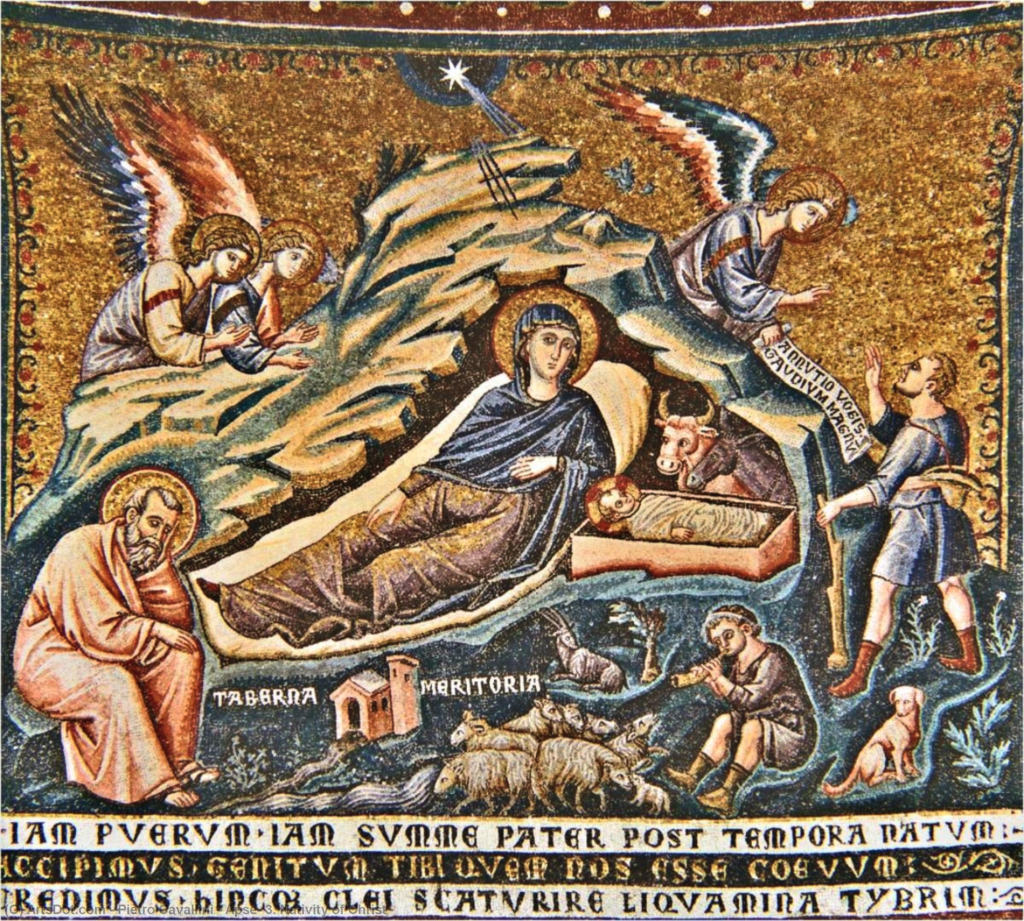
Mosaic by Pietro Cavallini, Rome, 1296 [Courtesy of Wikioo.org]
The Cavallini mosiac is modeled in the same general form as an even earlier work, also from Italy, that includes the mountain frame plus a baptismal bath (these elements were also copied into Greek and Russian works of the 15th century):
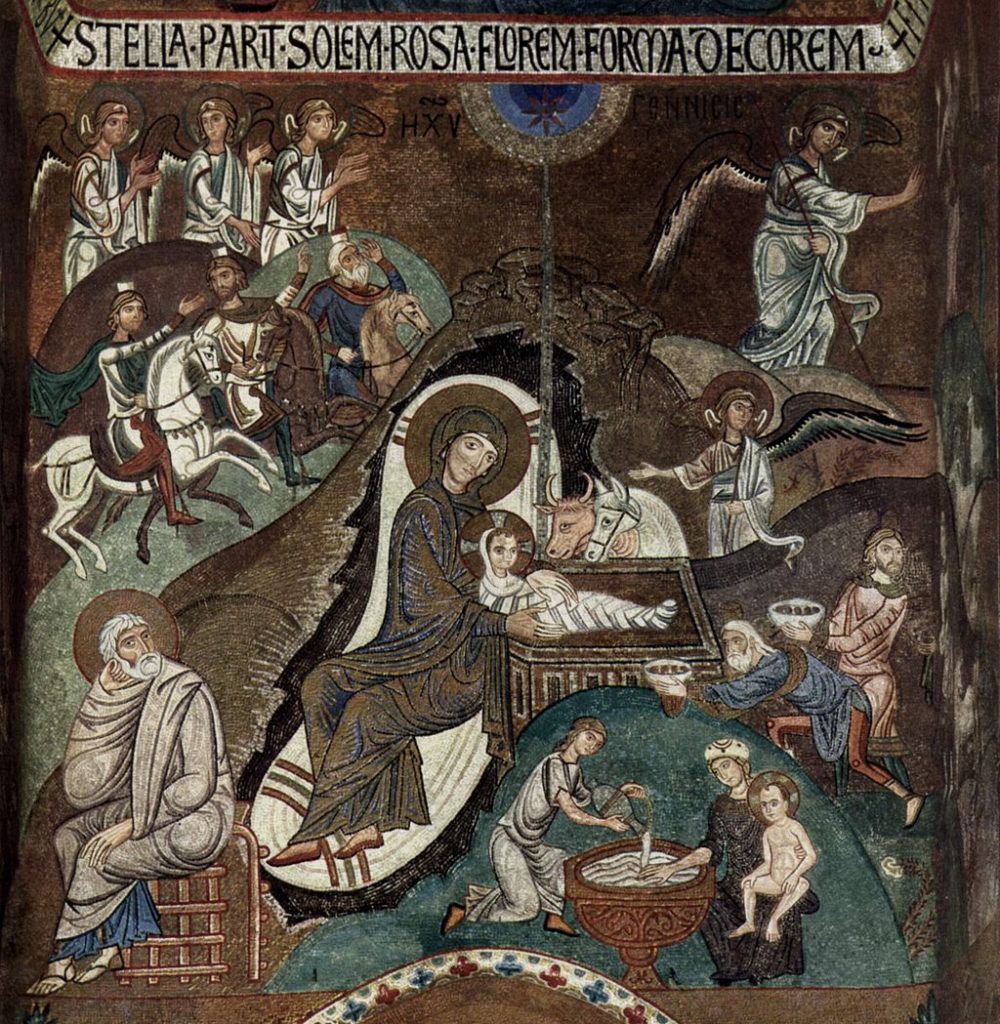
The Sacred Grotto
In this image, there is a windy road leading to a crater-like mountain. At the top of another hill are Mary and child resting in a garden-like setting with many plants, birds, and a deer (in another version of this painting, Patinier paints the garden like a small farm):
To the left and right are water, little roads and bridges (the city in the distance might be Marseille). Near the taller mountain are a couple of smaller ones, with traces of castles at the top.
Here is another version of the Sainte-Baume mountain by the same artist. Note the windy road, and the celestial spirit hovering over the edifice. This may represent ascension, or Mary elevated daily by angels:
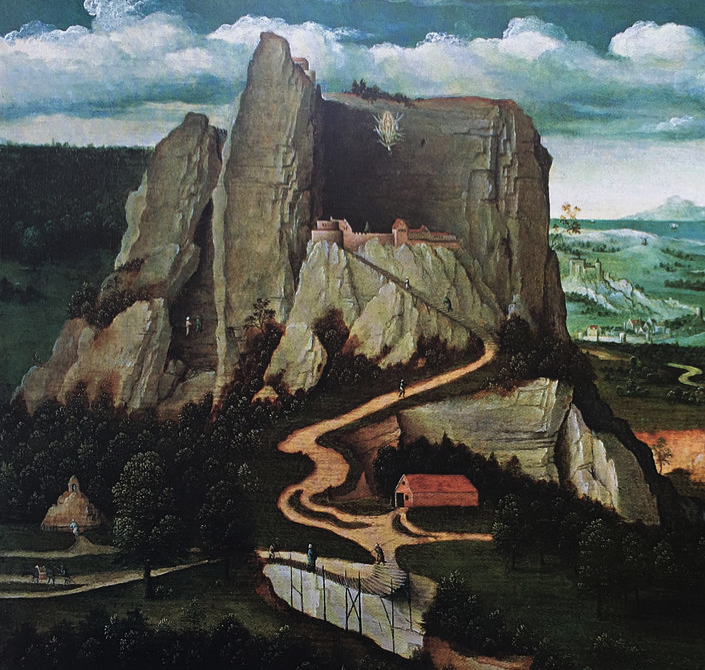
In other words, in thematic content, the paintings of Sainte-Baume have many features in common with the VMS “map”. Here is a snippet of the portion that resembles a mountain connected to a windy path:
Patinier has chosen to show the village as domes, towers, and connections to nearby hillocks with small bridges. Could this be the same location represented by the VMS central rotum?
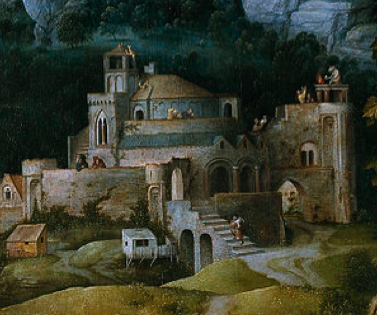
This particular series of paintings is based on a location in Provençe, the sacred grotto of Ste. Baume, which is still active as a pilgrimage site. Could the garden-like rotum on the bottom-right be the resting place of Mary on her journey?
Ghibelline merlons, as are found on the lower part of the VMS “map” were generally associated with Lombardy/Northern Italy, but they apparently also extended a short way into Provençe in the Middle Ages. I don’t know, however, if there were any in Marseille, which had its roots as a Greek colony.
Mary’s Journey
Stories vary, but one of the stories is that Mary of Magdalene fled persecution in a small boat and landed on the shores of Marseille. From there she traveled to the mountain of Ste. Baume where she took refuge in the grotto and made it her home.
Please note, there is considerable confusion over the different Marys in the Bible. Some say Mary Magdalene was the mother of Jesus. Others say Mary the Virgin, Mary Magdalene, and Mary of Egypt were all different people, and still others clearly describe “Mary the Magdalene of Egypt” as one person, but separate from Mary the mother of Jesus (I have seen “Mary the Magdalene of Egypt” written as though Mary Magdalene and Mary of Egypt were the same person in 15th-century manuscripts).
Plus, Mary Magdalene of the Gospels and Mary, the sister of Martha (who is said to have fled with Martha), may have been different people but were also sometimes considered the same.
Some of these divergent viewpoints are based on copying errors, but there were also differing opinions on how to interpret biblical passages, and different accounts by supposed historians. So keep in mind that sometimes the same person is illustrated standing next to herself, comic-book style, to indicate two different periods in her life, and other times they are two different Marys.
For the purpose of this blog, I will be referring to Mary of Magdalene who is said to have washed Jesus’s feet with her tears and a jar of ointment, the Mary who witnessed the resurrection and subsequently fled (with her supposed sister Martha), not the Mary who was Jesus’s mother (or the numerous other Marys in the Bible). I also mention Mary of Egypt who is often confused with Mary Magdalene. Be aware that the Mary who washed Jesus’s feet may not have been Mary Magdalene, even though many people in medieval times believed she was.
Now back to the sacred grotto…
Here is a postcard commemorating Ste. Baume, with Mary at the top, with three of her attributes, a skull, crucifix, and a chalice. She is flanked by two angels on puffs of clouds, with the Ste. Baume mountain and grotto buildings below. It gives us a hint of how the pilgrimage site may have looked in the 19th century:
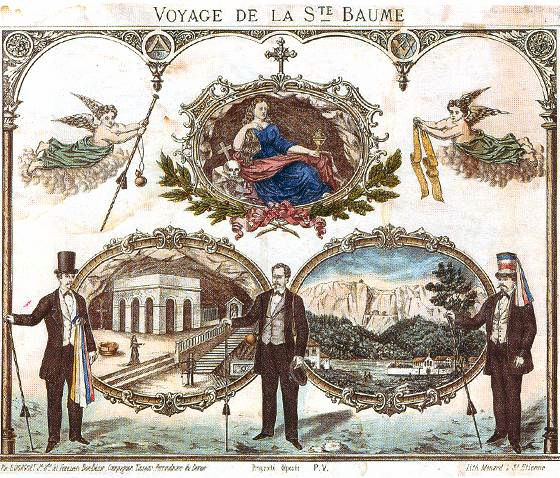
Sometimes Mary’s chalice is quite ornate (as in carvings in the region of Champeaux), similar to some of the domed containers in the VMS small-plants section. In other images, it is quite simple. If you go to this link, you will see a great variety of containers held in Mary’s hand.
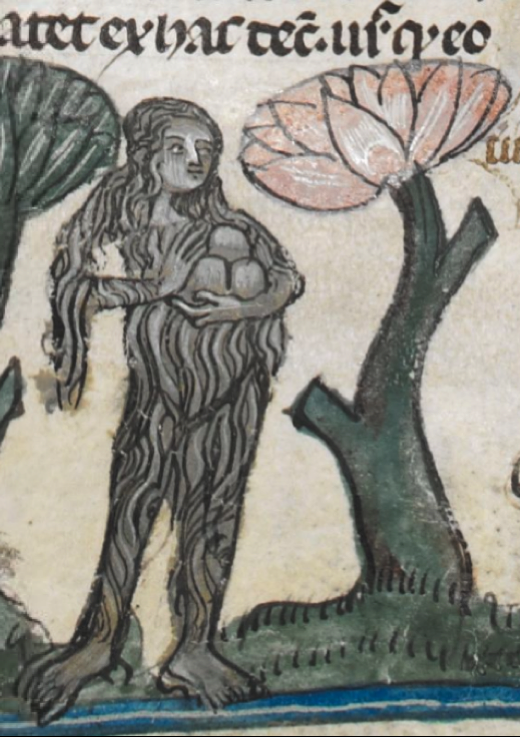
Her hairstyles vary, as well, depending on when the image was created (and by whom), but I thought readers might like to see this version of the hair and chalice (there are numerous nymphs with braids in the VMS), and this image on the right, with Mary in the wilderness completely enveloped by her hair. Both Mary Magdalene and Mary of Egypt are said to have wandered in the wilderness, and both are often shown with very long hair.
In fact, there are even more Marys. In this image, we have three Marys and their husbands: 1) Mary (wife of Joseph) , 2) Mary (wife or daughter of Clopas), and 3) Mary Salome (mother of John, the Evangelist):
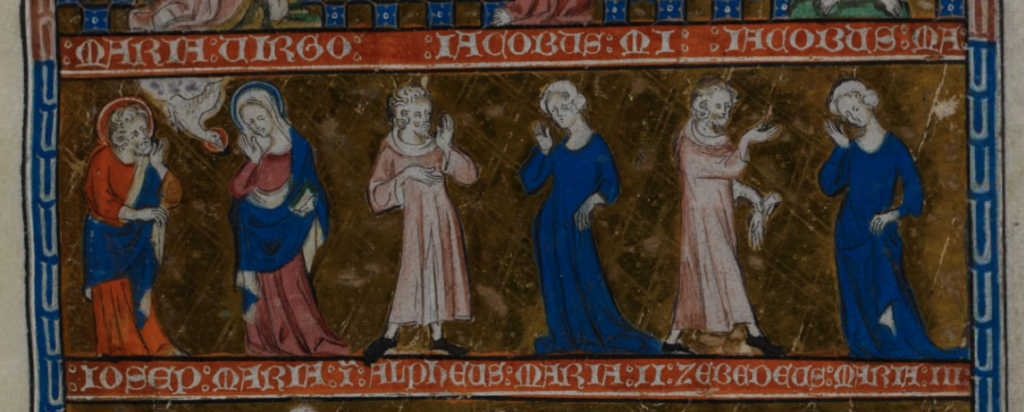
But, confusingly, there is a fourth Mary in this illumination… Mary the Virgin is pictured separately above Mary and Joseph (almost as though they are different people), with the dove (Holy Spirit?) between her and a man with a halo (one who is drawn differently from Joseph):
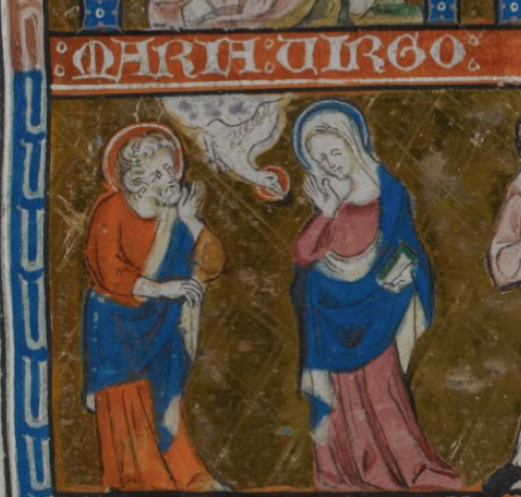
It’s easy to say, “Oh well, it’s just another point in time, when Mary became pregnant with Jesus” before she and Joseph started doing the hootchy kootchy, but you can’t just assume these things, you have to read the text and study the imagery in context with the other Mary stories.
In other words, there were numerous Marys, and some perceived them as different people, others as the same. Even if they agreed that it was Mary the Magdalene who fled to Provençe and she was different from Mary of Egypt, there were still different narratives about where Mary Magdalene actually went and what happened to her once she got there.
How This Relates to the VMS
Unfortunately, if there is Christian imagery under the surface of the Voynich Manuscript, and if any of it relates to Mary, the profusion of stories about her whereabouts and her physical characteristics (as seen through medieval eyes) will make it harder to match up VMS imagery with any specific account. Plus, there are several VMS nymphs with very long hair.
In this image, Mary Magdalene is shown with a chalice and Mary of Egypt with very long hair:
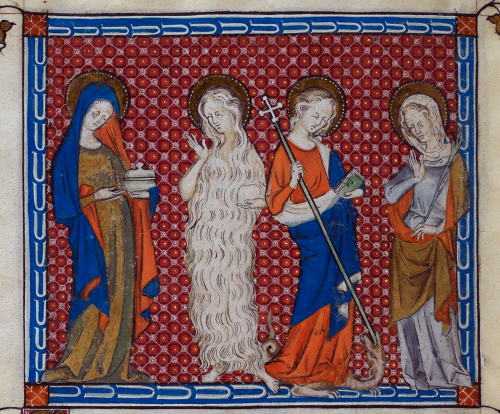
It’s possible that Mary Magdalene and Mary of Egypt are confused because both were described as sinful women who were cleansed of their sins.
Here Mary (this should be Mary of Egypt) has long hair and a hair coat:
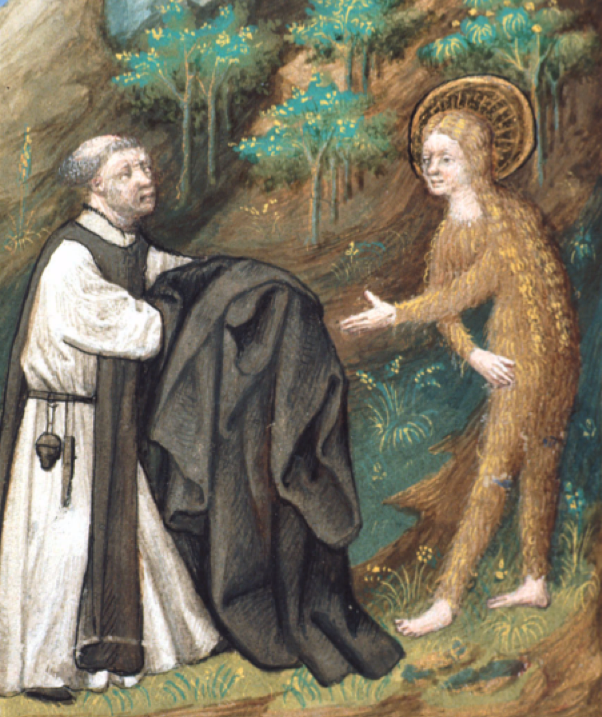
The hair-suit is an iconic way of indicating someone who is living wild, separate from civilization. Not every illustrator covered Mary in hair. Some of the Greek manuscripts show Mary naked.
In this illustration, the idea of the hair suit relating to wilderness is made stronger by surrounding Mary with monkeys:
Relating Mary to the VMS “Map” Folio
Keeping in mind that there are many Marys and sometimes their stories overlap, let’s focus on the boat story of Mary Magdalene, the Mary who is most often credited with witnessing the resurrection, and fleeing with her siblings to a distant shore.
The following image combines many elements of the flight of Mary. She traveled by boat to Marseilles, where she continued on foot through forests and farms and moved into the mountain of Ste. Baume. In this instance, she’s not wearing a wilderness style “hair suit”. Instead, she is covered in her own long hair during her daily ride with angels:
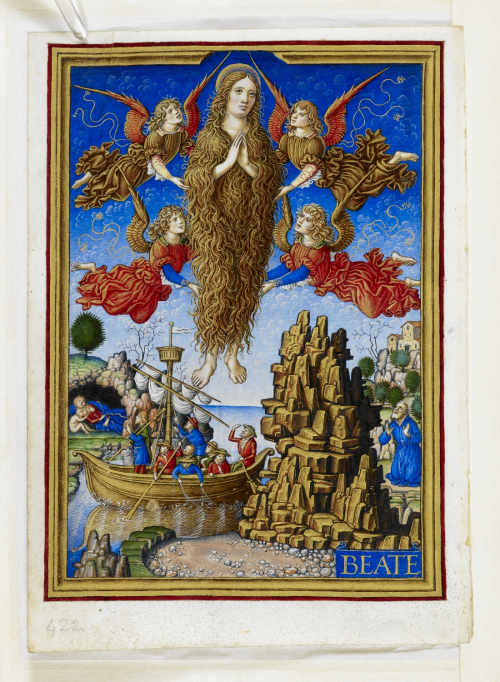
Here is a less elaborate drawing from the early 14th century. Mary (of Egypt) is holding the three loaves of bread she took into the wilderness, and nearby is a boat:
The story continues with Mary’s hair growing very long to convey her lengthy stay in the wilderness. The three loaves are nearby to make it clear that this is Mary (if you didn’t know the story behind it, you might mistake them for stones or tablets):
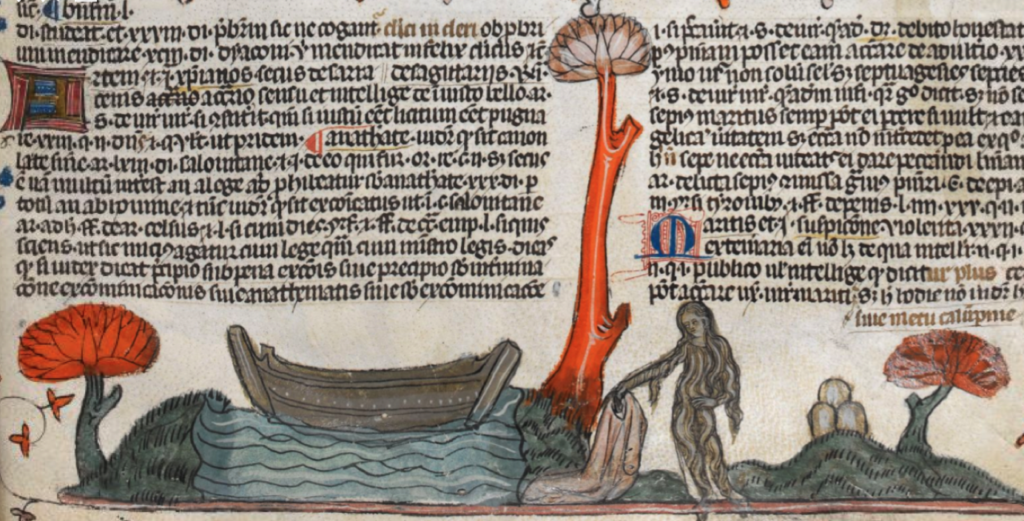
Mary is shown beneath a tree, among the birds and boars (this garden-and-animals theme occurs in numerous Mary illustrations):
After several decades, Mary is so engulfed in hair, she is almost unrecognizable:
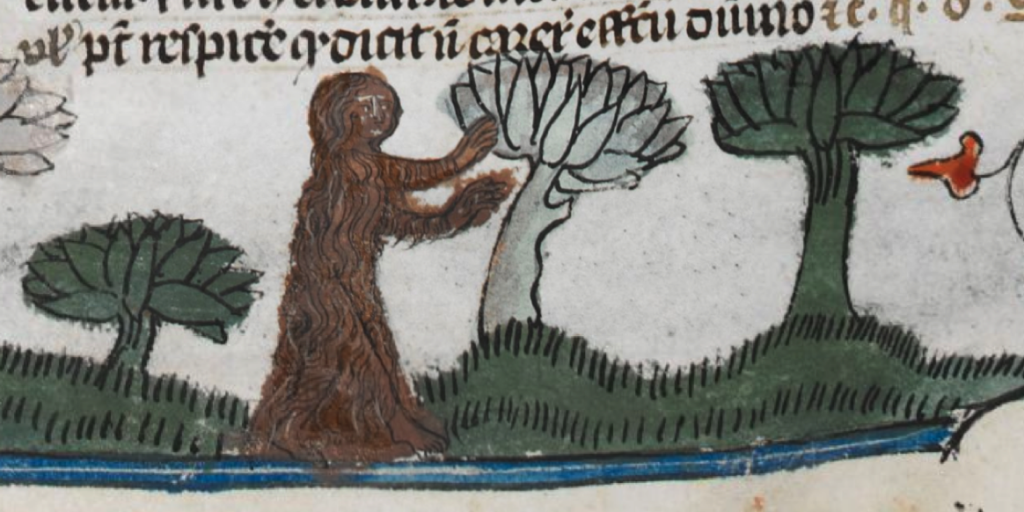
Mary’s time is almost up, she meets a passing saint and she dies in the wilderness one or three years later. In some accounts, she receives last communion back at her cave and in still others, she receives last communion at the river Jordan:
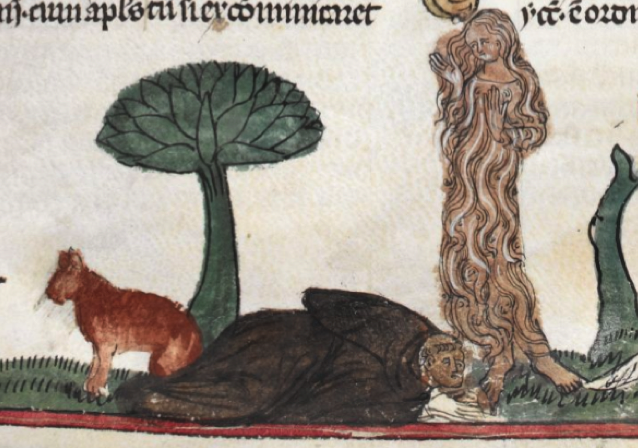
The following example, from the Life of Mary, focuses on Zosimus giving Mary of Egypt a cloak, as she looks out through the crags of her grotto. Even though the cloak is usually associated with Mary of Egypt, the fresco is in the Magdalene Chapel in Assisi:
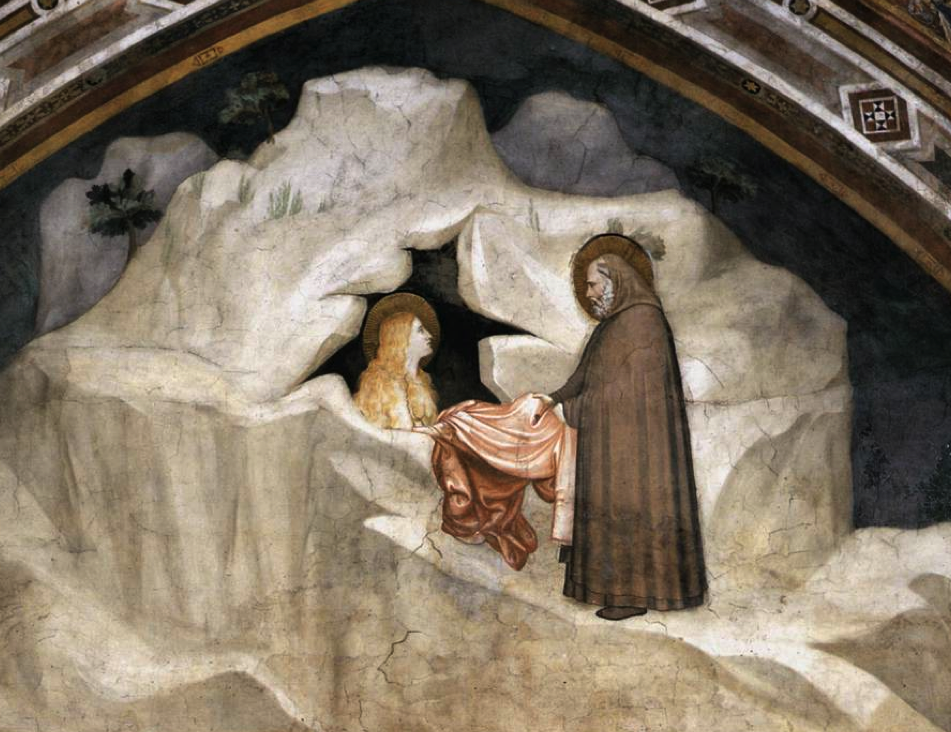
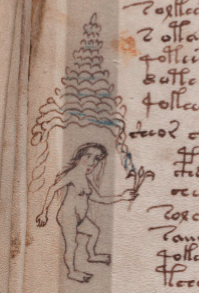
When I was pondering the figure at the top of folio 76v, I wondered whether this long-haired lady with the plant might represent Mary in her holy grotto (the shape of the arch-like texture is somewhat like an altar). Mary is shown with a halo and a stalk of grain in a Lombardic manuscript by the Master of Monza. Mary of Egypt was usually shown with three loaves, but sometimes with a sheaf of grain.
The VMS nymph is a bit thin and disheveled compared to many of the other nymphs. Could this be wilderness Mary?
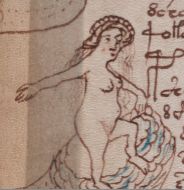
According to one version, Mary asked Zosimus (also called Maximin) to meet her on the banks of the Jordan River so that he could grant her Holy Communion. In the lower part of this folio, a long-haired nymph appears to be stepping into water and swimming. Could this be the River Jordan?
I’m not sure what to make of the second nymph, the one holding a red-striped and dotted “thing”. The “thing” looks vaguely like a loaded spindle (very vaguely), but could it be a cross between a spindle and a rolled-up cloak (with thread being the unifying idea)? I’m not confident about the ID of the strange red object, and the nymph holding it doesn’t have long hair, so I’m not sure how it ties in with the drawings around it (assuming there is a connection), so I’ll ruminate a while longer.
The figure in the top right of the folio is ambiguous, possibly male, and may relate to what is happening on the facing folio (unbound) rather than what is on this folio, but if it is male, maybe it’s Zosimus. His crypt is said to have sheltered the tomb of Mary Magdalene in Provençe (which again is a bit of a stretch since Mary of Egypt was born quite some time after Mary Magdalene).
Links Between the Iconography of Mary and the Passion of Christ
I have something of particular interest for those who have been following recent developments in Voynich research…
At the Victoria and Albert Museum, there is an embroidery of Mary Magdalene surrounded by her attributes (ointment chalice, crucifix, skull, buildings in the distance) and yet the border includes implements from the Arma Christi. The two kinds of imagery are not usually combined, and when they are, Jesus is usually the focal figure. In this one, Mary dominates the frame and Jesus is not present.
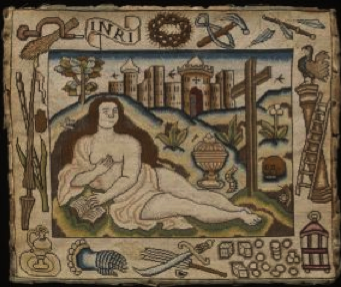
The embroidery is not medieval—it is from the 17th century and I can only post a thumbnail, but you can click here for the Victoria & Albert Museum to see it full-sized. Note that there are 16 coins (it doesn’t have to be 30 as long as the meaning is clear). There is no helical rope around the flagellation pole, but it immediately made me wonder, is there an earlier image of Mary Magdalene together with Arma Christi implements that inspired this one? Could this combination of themes be relevant to the VMS?
Are there Arma Christi narratives encoded in the plants as discussed in the previous blog, with the story of Mary Magdalen included elsewhere?
Another Look at the VMS “Map” Folio
So coming back to the “map” folio, is it possible to relate some of the features to Mary’s journey?
Ste. Baume is a very hilly area, with a rippled geology that would be difficult to tread on foot, so the paths are mostly to the side of the many peaks and valleys shown in this aerial photo. These corrugated hills are reminiscent of the VMS escarpments. When traveling on foot, one would see their regular rise and fall and possibly some of the bands of color:
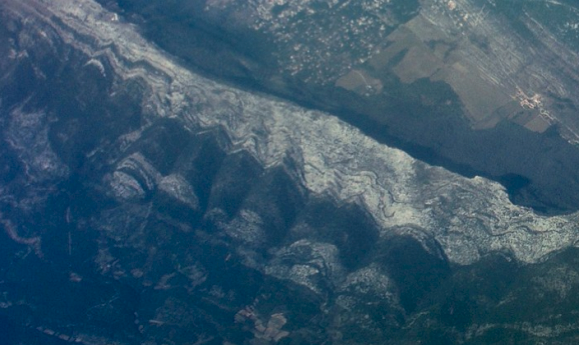
[Aerial photo courtesy of Adrian Tync, Wikimedia].
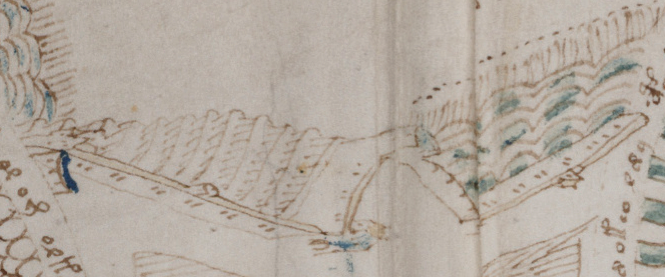
The inner grotto, where Mary lived before venturing into the wilderness, has a modern shrine, which was probably much simpler in the Middle Ages:
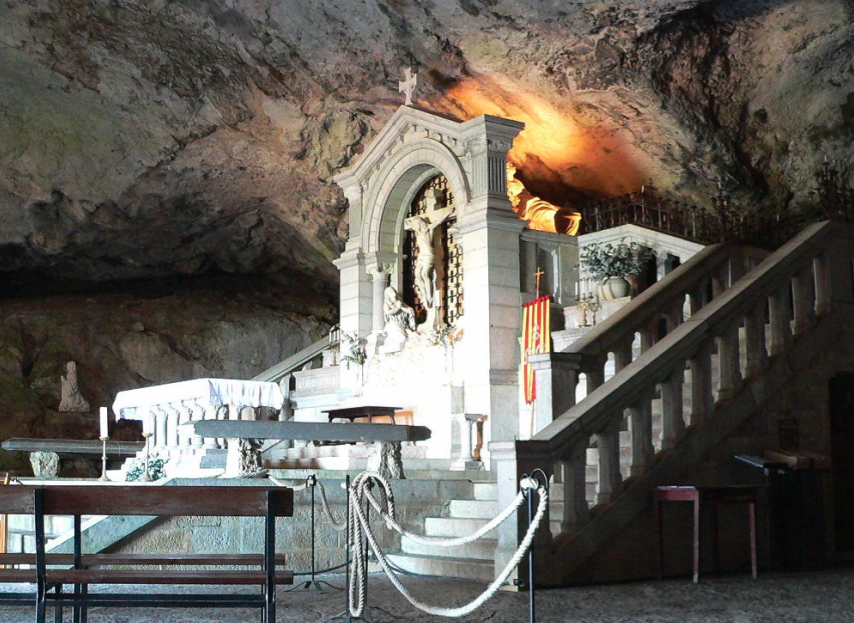
Provençe is also home to bathing pools and waterfalls, a theme that occurs in numerous VMS folios:
Provençe is known for some of its round towers (in contrast to the more common square ones). The VMS tower-in-the-hole is also round, which might have have been inspired by architecture in Lombardy, Pisa, or Provençe.
Going back to my early idea about Jerusalem, the Mary Magdalene church, built on the Mount of Olives, looks somewhat like the onion-dome towers in the VMS central rotum, but it was built in the 19th century and the previous building was a single tower with a less rounded dome:
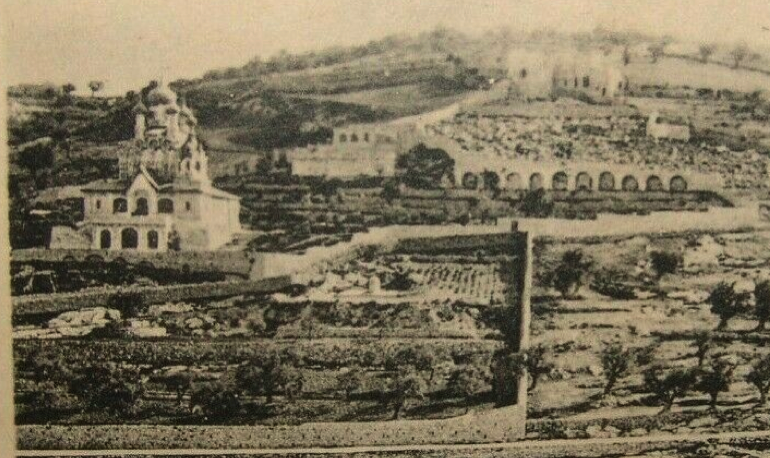
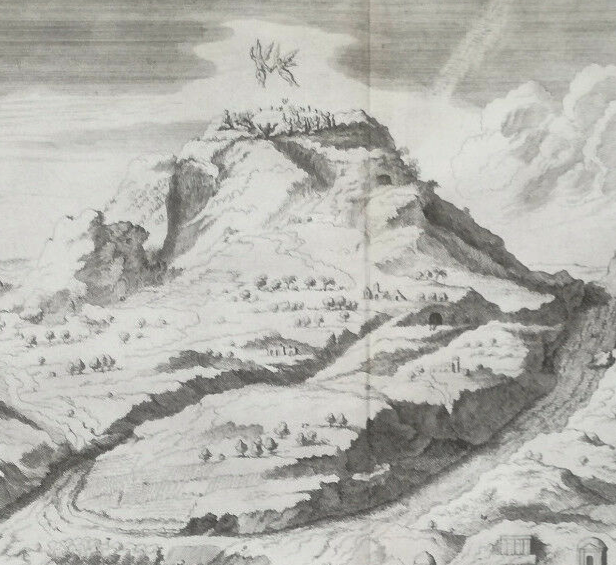
I’m inclined to believe that the “towers” in the central VMS rotum are a combination of containers (possibly spice containers) and architectural towers, rather than a drawing of an actual building. They might represent towers in the metaphorical sense, or even a specific building in a vague kind of way, but I doubt if it’s meant to be taken literally—towers don’t usually have feet.
Summary
So is it possible the VMS “map” represents Mary’s journey or landmarks to the pilgrimage site?
This is pretty speculative, but I still think the VMS “map” might be drawn on two levels—a corporeal level and a spiritual level. I’ve ghosted out the spiritual level for this example.
Now assuming the four corners are more literal than the others, perhaps the bottom right (which I thought years ago might be the garden of Gethsemane) is the farm-like landscape shown in Mary’s journeys. The top-right, with the “big water” might be the port of Marseille, where Mary’s battered boat came ashore. The top-left seems like a reasonable guess for the mountain grotto where she lived for a time, and the bottom-left might be the various arms of the Durance river:
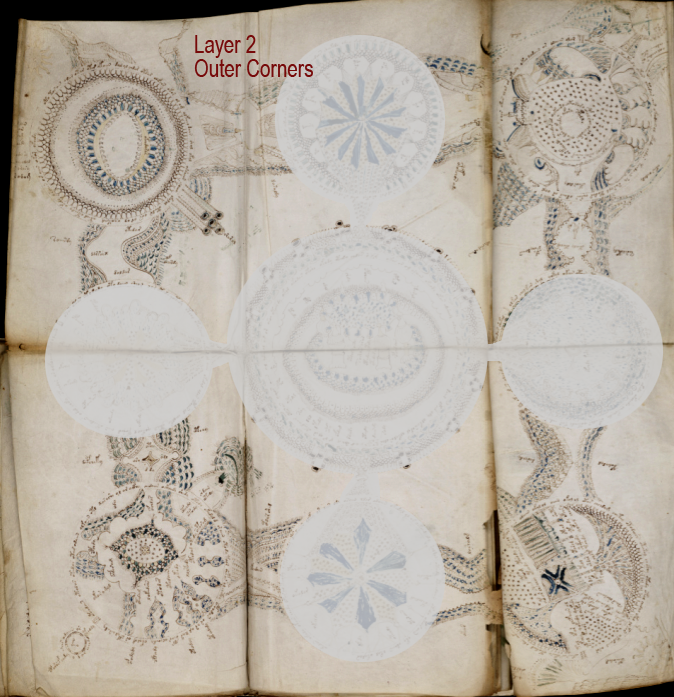
This is what Marseille looked like in the 16th century. Note the rows of windmills—the patterns in the 2nd and 8th rota on the VMS “map” have always reminded me of fountains, water wheels, and windmills:
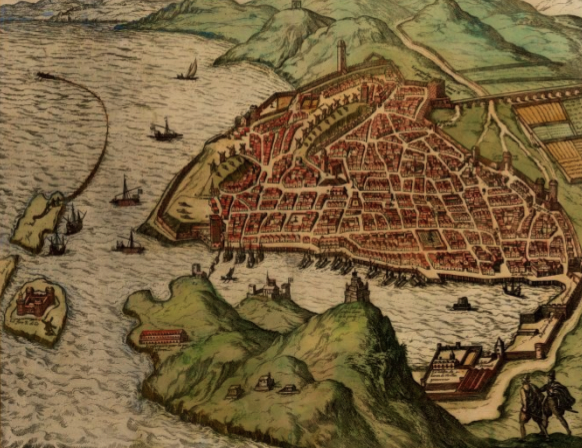
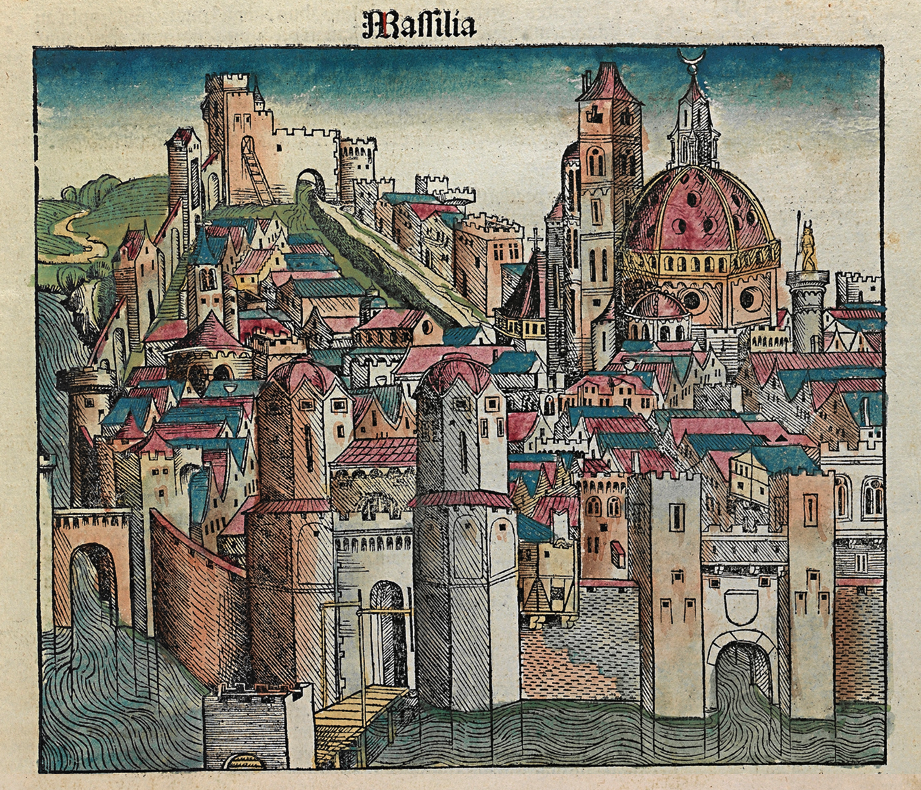
On modern roads, it is about an hour’s drive from Marseille to Sainte-Baume. In medieval times, it was probably three weeks journey by foot.
There are numerous possibilities for the VMS map… Jerusalem, a predecessor to Villa d’Este, Naples/Baia/Salerno, Tuscany, Venice, Rhodes, and numerous others, but I thought I would add a biblical journey so there’s at least one mythical map on the list.
J.K. Petersen
© Copyright 2019 J.K. Petersen, All Rights Reserved


